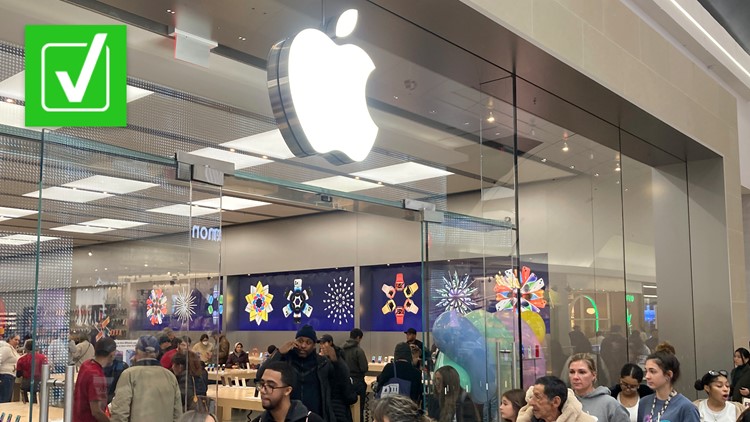Some MacBook owners received emails or postcards in December and January notifying them of a settlement. It said that if you bought a MacBook between 2015 and 2019 that was equipped with a “butterfly” keyboard, you might be eligible for a payment.
All of the breakout Google searches for MacBooks over the past month have been about this settlement, as people seek out more information.
THE QUESTION
Is there a settlement for MacBooks with keyboard issues?
THE SOURCES
THE ANSWER
Yes, there is a settlement for MacBooks with keyboard issues.
WHAT WE FOUND
According to the settlement’s website, a lawsuit alleged that Apple sold MacBook laptops with defective “butterfly” keyboards between 2015 and 2019. These were keyboards that used an “Apple-designed butterfly mechanism” that Apple claimed was “40% thinner than a traditional keyboard scissor mechanism yet four times more stable.”
But these keyboards had a host of problems, the settlement website claims, which caused characters to repeat unexpectedly, letters or characters to not appear and/or keys to feel “sticky” or not respond in a consistent manner.
The lawsuit, filed July 2020, alleges Apple knew about these defects and continued to sell MacBooks with these keyboards without informing customers of their potential issues. It adds that when Apple opened up its Keyboard Service Program to repair such keyboards for free in 2018, the repairs were inadequate and the keyboards’ problems would persist even after the repairs.
This settlement compensates people who went to Apple or an authorized service provider to repair their keyboards, but continued to experience issues. Eligible consumers can only be paid once per computer, which means people with multiple affected MacBooks may be eligible for multiple payments.
According to the settlement website’s FAQ page and Apple’s Keyboard Service Program webpage, there are 16 models covered by this settlement. Those models are:
- MacBook (Retina, 12-inch): early 2015, 2016, 2017
- MacBook Air (Retina, 13-inch): 2018, 2019
- MacBook Pro (13-inch, Two Thunderbolt 3 Ports): 2016, 2017, 2019
- MacBook Pro (13-inch, Four Thunderbolt 3 Ports): 2016, 2017, 2018, 2019
- MacBook Pro (15-inch): 2016, 2017, 2018, 2019
If you’re unsure whether your MacBook is one of these models, you can check by inputting your serial number into Apple’s service coverage page.
The settlement then divides eligible claimants into three groups based on Apple’s repair records. Group 1 doesn’t have to file a claim to receive their money, while Groups 2 and 3 do.
Group 1 is made up of people who, within four years of their purchase, obtained two or more “topcase replacements” of their keyboard. A topcase replacement is when Apple or one of its authorized service providers replaces the full keyboard module — which includes the battery, trackpad, speakers, top case and keyboard itself. Group 1 members will receive a payment between $300 and $395.
Group 2 class members are people who obtained one topcase replacement within four years of their purchase, and who attest on their claim form that the repair did not resolve their keyboard issues. Group 2 members may receive as much as $125 in payment.
Group 3 is for people who obtained one or more keycap replacements, but no topcase replacements, within four years of their purchase that did not resolve their keyboard issues. Group 3 members may receive up to $50.
There is also a Group 4 of people who could qualify if they have proof of repair. Group 4 is made up of people who bought a qualifying MacBook, but lack a qualifying repair within Apple’s records.
The claim filing deadline is March 6, 2023, and claims can be made through this online form. You will need the unique ID and PIN included on the email or postcard you received.
If you didn’t receive an email or postcard, or you received a Group 4 notice that did not include the unique ID and PIN, you must fill out this separate claim form and submit proof that you purchased an eligible MacBook and provide “reasonable documentation” that you obtained one of the eligible repairs.
About 750,000 people in Groups 1, 2 and 3 have been sent email or postcard notices. Another 10 million received notices as part of Group 4.
If you wish to opt out or object to the settlement, your deadline is Feb. 10, 2023. Objecting to the settlement means you have an issue with the settlement that you wish to submit to the court. Opting out of the settlement means you wish not to be a part of it, which allows you to retain your right to sue Apple individually. You cannot object to the settlement if you opt out of it.
You can still seek repairs through Apple’s Keyboard Service Program, even if you receive money from the settlement. However, you can only use this program within four years of your purchase of your MacBook.
Although Apple did not respond to VERIFY’s request for comment by the time of publishing, the settlement agreement does clarify that Apple’s agreement to the settlement’s terms is not an admission of wrongdoing.
“Apple denies all of the allegations made in the lawsuit, denies that any MacBooks are defective, and denies that Apple did anything improper or unlawful,” the settlement agreement says. “Apple asserts numerous defenses to the claims in this case. The proposed settlement to resolve this case is not an admission of guilt or wrongdoing of any kind by Apple.”



